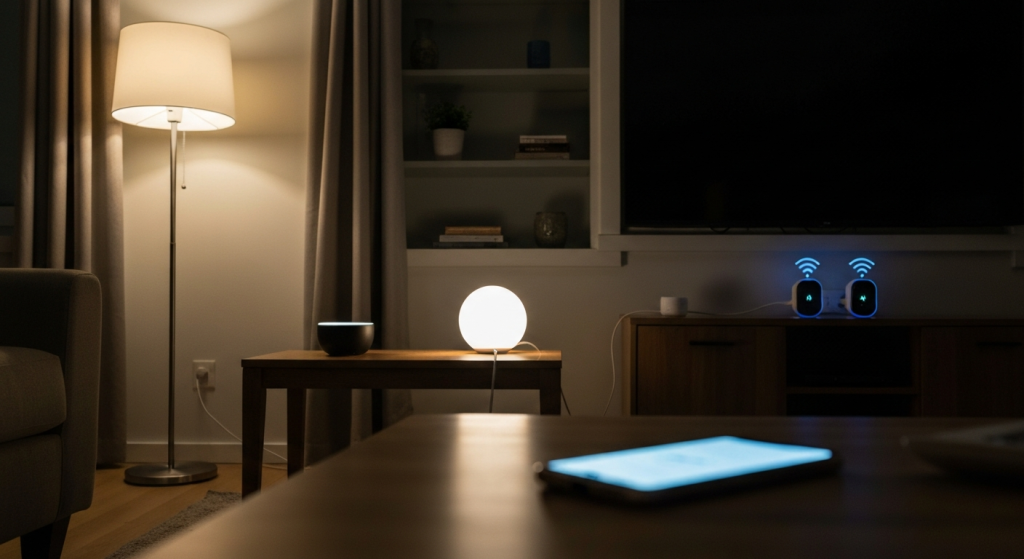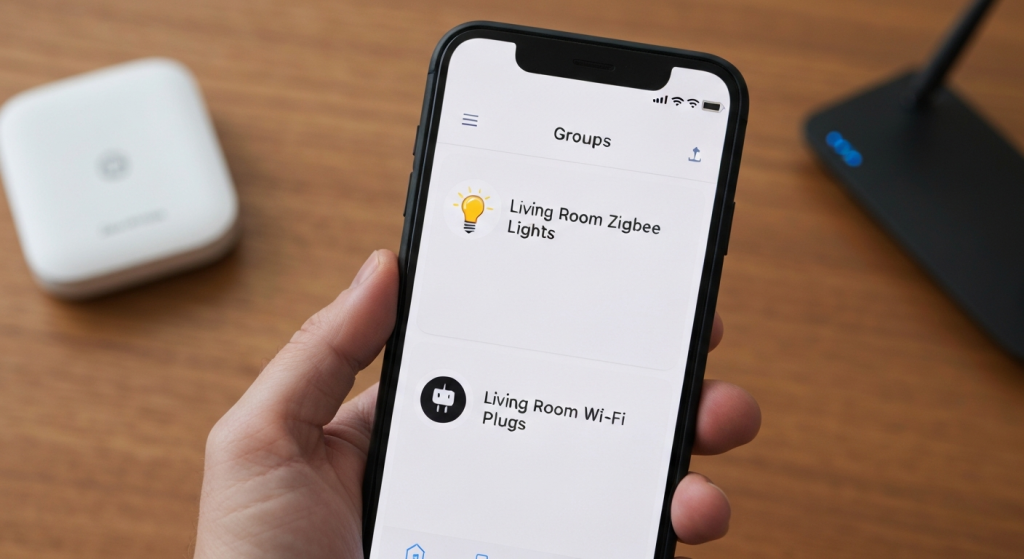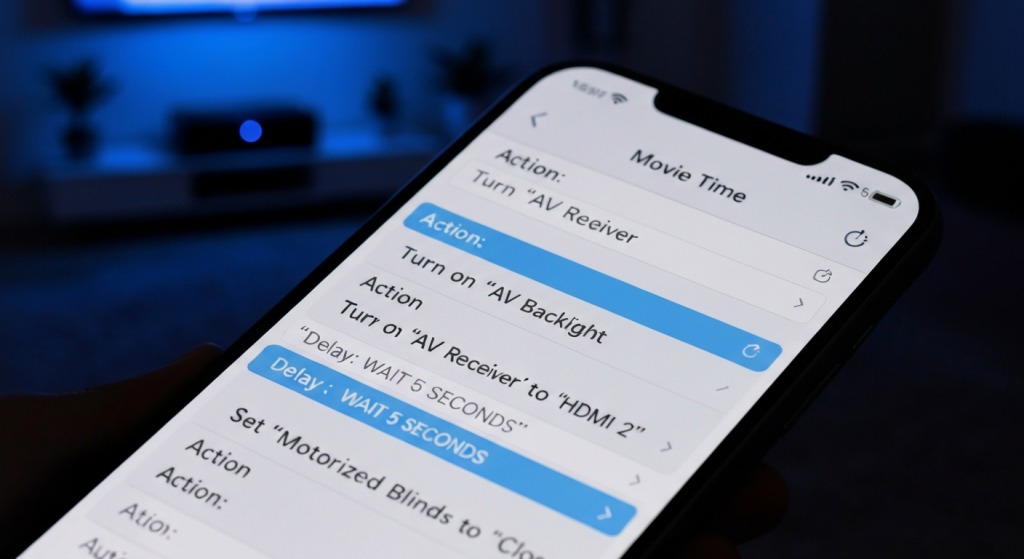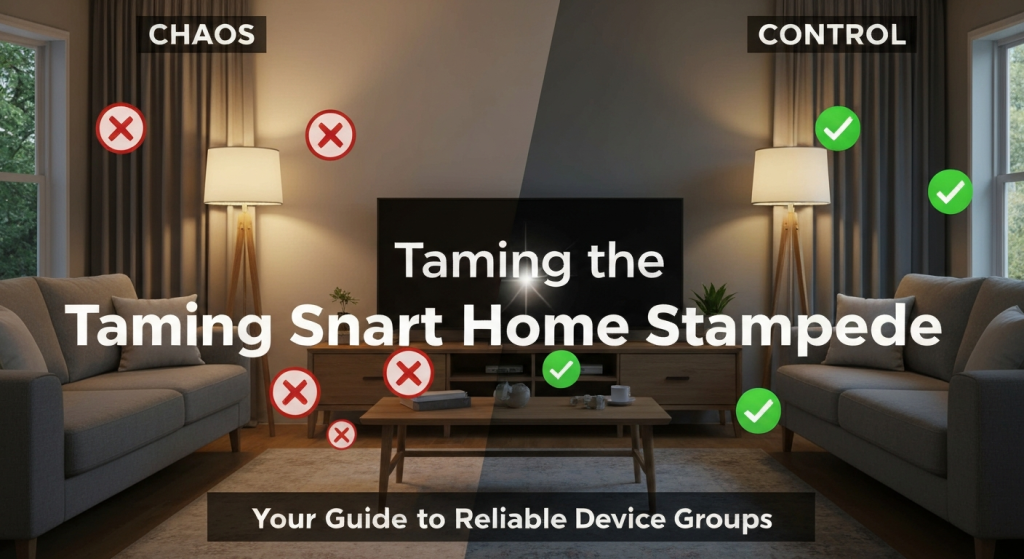We’ve all been there. You say the magic words, “Hey Google, turn off the living room,” and instead of a crisp, satisfying “click,” you get a chaotic light show. The table lamp turns off instantly, the floor lamp flickers and thinks about it, and the smart plug in the corner goes off a full three seconds later. It’s the smart home “popcorn effect,” and it’s deeply frustrating. We build smart homes to make life simpler, but misbehaving groups just create a new kind of digital chaos.
The good news is that this isn’t random. There are clear reasons why your devices “fight” each other and why your groups feel so unreliable. It often comes down to mismatched technologies and overloaded networks.
Hello! I’m Mahnoor Farooq. For the past five years or so, I’ve been completely immersed in the world of smart home automation, figuring out what makes these gadgets tick (and what makes them fail). I’m not an engineer, but I am intensely curious. I’ve spent countless hours testing routines, breaking device groups, and putting them back together. My goal is to share what I’ve learned from all that tinkering, bringing research and hands-on experience to help you get your smart home working for you, not against you.
This post is all about diagnosing the problem of “group chaos” and giving you the practical strategies I use to fix it. We’ll go beyond the basic app settings and look at the real-world solutions that power users rely on to create a truly synchronized and reliable smart home.
Why Your Smart Device Groups Feel So Unreliable

Before we can fix the problem, we have to understand the why. When I first started, I assumed all smart devices were basically the same. I’d buy a Wi-Fi bulb here and a Zigbee plug there, toss them all into an Alexa group, and then wonder why it was so flaky. The truth is, what’s happening under the hood is completely different for each device. The chaos almost always stems from one of these three issues.
The “Popcorn Effect”: Understanding Device Response Times
This is the most common problem. You give one command, but your devices react at different speeds. This lag, or latency, is caused by the different ways they talk to your hub or router.
- Wi-Fi Devices: These are very common. Each bulb or plug connects directly to your Wi-Fi router. This sounds simple, but it can be slow. The command has to go from your phone (or speaker) to the cloud (a server on the internet) and then back to your router, which then has to tell the specific bulb what to do.
- Zigbee/Z-Wave Devices: These are my personal favorites for reliability. They use a different, low-energy signal to create their own “mesh” network. They all talk to a central hub (like a SmartThings or Hubitat hub). The command goes to the hub, which then blasts it out to the devices. This is often much faster because it can happen inside your house without the internet.
- Cloud vs. Local Control: This is the big one. If your command must go to the internet and back, it’s “Cloud Control.” It’s vulnerable to internet outages and server lag. “Local Control” means the command is processed entirely inside your home network. For group commands, local control is the gold standard for speed.
I once had a “Good Morning” routine where my cloud-based Wi-Fi kettle would boil, but my locally controlled Zigbee blinds wouldn’t start opening for another two seconds. It felt completely disconnected. Switching to devices that all ran locally made it feel instant and seamless.
When “On” and “Off” Collide: The State Mismatch Problem
This is what I call the “group fight.” It happens when you, the user, get frustrated by the popcorn effect and send a second command.
Here’s a real-world example. I had a “Movie Time” scene:
- Living Room Lights (Wi-Fi): Dim to 10%
- TV (Smart Plug): Turn On
- Motorized Blinds (Zigbee): Close
The lights would dim instantly (fast Wi-Fi), but the blinds (slower Zigbee) would just start moving. Thinking it failed, I’d hit the “Movie Time” button again. The app, in its confusion, would see the lights were on (at 10%) and its next instruction was to turn them off. Meanwhile, the blinds, which were halfway down, would just stop. The whole scene was a disaster, with devices fighting each other because they were all in different states.
The “Too Many Cooks” Issue: Network and Hub Overload
Your home network is like a highway. When you tell a group of 10 Wi-Fi bulbs to turn on at the exact same millisecond, it’s like 10 cars trying to merge into one lane at the same time. This is “network congestion.” Packets get lost, commands get dropped, and one or two bulbs in the group simply fail to respond.
This is especially true for Wi-Fi devices, which are all competing for airtime with your phone, your laptop, and your Netflix stream. This problem gets worse as you add more and more devices. For Zigbee or Z-Wave, a weak hub can be the bottleneck. If the hub’s processor is slow, it can’t “talk” to 30 devices at once, and you get the same staggered, popcorn effect.
Strategy 1: Building Smarter, More Resilient Groups

The fix for all this chaos is to be more intentional. Instead of just dumping devices into a group, we need to build our groups around the technology itself.
Grouping by Protocol (The “Like with Like” Method)
This was the first major change I made, and it improved things overnight. I stopped making “Living Room” groups. Instead, I made:
- “Living Room Zigbee Lights” (all my fast, local devices)
- “Living Room Wi-Fi Plugs” (all my slower, cloud devices)
These groups, filled with “like” devices, became incredibly reliable. The “Living Room Zigbee” group turned on and off with a single, satisfying snap. They all spoke the same language at the same speed.
“But,” you ask, “I still want to control the whole room.” That’s where routines come in. In my Alexa app, I created a new routine called “Living Room Off.”
- Trigger: “Alexa, living room off.”
- Action 1: Turn off the group “Living Room Zigbee Lights.”
- Action 2: Turn off the group “Living Room Wi-Fi Plugs.”
The app fires both commands, and because the individual groups are so reliable, the whole room shuts down perfectly, even if the Wi-Fi plugs are half a second behind the Zigbee lights. It’s an organized, staggered shutdown, not a chaotic mess.
Using a Hub for Local Control
If you’re a power user with a lot of devices, a dedicated smart home hub is the single best upgrade you can make. A hub (like those from Hubitat, Home Assistant, or SmartThings) acts as the “brain” for your home. Its primary job is to process commands locally.
When I moved all my Zigbee and Z-Wave devices to a local hub, my group control became instant. I could hit a button, and 15 lights would respond as one. There was no trip to the internet. No cloud lag.
I put together this simple table to show what a difference this makes. This isn’t lab data; it’s just my observation from years of using both.
| Feature | Cloud-Based Control (e.g., App to Wi-Fi Bulb) | Local Hub Control (e.g., Hub to Zigbee Bulb) |
| Command Path | Phone $\rightarrow$ Wi-Fi Router $\rightarrow$ Internet $\rightarrow$ Brand’s Server $\rightarrow$ Internet $\rightarrow$ Wi-Fi Router $\rightarrow$ Device | Phone $\rightarrow$ Wi-Fi Router $\rightarrow$ Local Hub $\rightarrow$ Device |
| Typical Speed | 0.5 – 3.0 seconds | < 0.2 seconds (feels instant) |
| Needs Internet? | Yes. If your internet is down, it fails. | No. Works even if the internet is out. |
| Reliability | Moderate. Prone to lag and server issues. | Very High. Rock-solid for group commands. |
Looking at the command path really made it click for me. The cloud route just has so many more places to fail before the signal even reaches your light bulb.
Strategy 2: Using Scenes and Routines to “Fake” Synchronization

Sometimes, you can’t group like with like. My “Movie Time” example is perfect: it involves lights, a plug, and blinds. They are all different technologies and have different response times. The solution is to stop using a simple “group” and start orchestrating a “scene” or “routine.”
The Power of a “Scene” vs. a “Group”
This is a key concept.
- A Group just bundles devices to receive the same command (e.g., “On” or “Off” or “Set to 50%”). It’s dumb and just blasts the command to all of them.
- A Scene or Routine is a scripted sequence of events. It sets a specific state for each device (Light A to Blue, Light B to 10%, Plug C to Off). This is where you can be a director.
Instead of a “Movie” group, I built a “Movie” routine. This is where you, the power user, can outsmart the technology.
The Staggered Routine: Your Best Friend for Slow Devices
This is my number one trick for groups with mixed-speed devices. You build delays into your routine to account for the lag. It lets you force a chaotic group to behave in an orderly fashion.
Here is my actual “Movie Time” routine, which now works 100% of the time:
- Trigger: “Alexa, it’s movie time.”
- Action 1 (Instant): Turn on “Living Room Zigbee Lights” (and set to 5% blue).
- Action 2 (Instant): Turn on “TV Backlight” (Wi-Fi plug).
- Action 3 (Needs boot time): Turn on “AV Receiver” (smart plug).
- Action 4 (WAIT 5 SECONDS): This is the magic.
- Action 5 (After delay): Send “Input to HDMI 2” command to TV (this gives the receiver time to fully boot up).
- Action 6 (After delay): Set “Motorized Blinds” to “Close.”
That 5-second delay was the game-changer. It stopped my TV from trying to switch inputs before the receiver was even ready. The blinds close last, which is fine. The whole process feels deliberate and smooth. It’s no longer a chaotic stampede; it’s a planned sequence of events.
What About Different Brands? Solving the “Ecosystem” Problem
Even with these tricks, you can run into walls. What if you have a Google Home-only device and a HomeKit-only device? They live in separate worlds.
The Role of Matter
You’ve probably heard about Matter. This is a new, universal smart home standard that is designed to fix this exact problem. The goal is for any Matter-certified device (no matter the brand) to talk to any Matter-certified hub or app.
In theory, this will make grouping devices much, much simpler. A Matter-certified light from Philips Hue and a Matter-certified plug from TP-Link should respond to a group command with the same speed and reliability. It’s still new, but as you buy new devices, looking for the Matter logo is a very smart way to future-proof your home and reduce group chaos. This is all managed by the official Matter standard, which is a great resource to follow.
When to Use a “Bridge” Platform (and When Not To)
Platforms like IFTTT (If This Then That) or the advanced Home Assistant software can act as a “bridge” to connect otherwise incompatible devices. You can, for example, make your Ring doorbell (Amazon) flash your Wyze lights (no ecosystem).
But—and this is a big “but” for power users—these bridges often add massive cloud-to-cloud latency. They are the ultimate “Cloud Control” and can make your group lag even worse.
I put my rules for using these into a simple pros and cons table.
| Bridge Platforms (like IFTTT) | Pros | Cons |
| What they’re good for | Ultimate Compatibility. Connects anything to anything. | Extreme Lag. A command can take 5-10 seconds. |
| Example Use | Great for non-urgent tasks. “If my soil sensor is dry, add ‘Water Plants’ to my to-do list.” | Terrible for Groups. Do not use this to group your main lights. It will be painfully slow. |
My personal rule: I use these bridge services for background tasks and automation. I never use them for real-time control like light groups.
Troubleshooting: When Good Groups Go Bad
Sometimes, a group that has worked perfectly for months suddenly starts to fail. Here’s my checklist for fixing it.
Start with the Network
This is the culprit 90% of the time. Don’t blame the bulbs; blame the highway.
- Reboot Your Router: This is step one. Always. It clears out temporary traffic jams.
- Check Your Channels: Most routers have 2.4GHz and 5GHz bands. Most smart devices only use the crowded 2.4GHz band. Your phone, laptop, and 50 smart bulbs are all fighting for space.
- My Pro-Tip: I solved this for good by creating a separate, dedicated 2.4GHz “Guest” network on my router. I named it “SmartHomeIoT” and connected only my smart devices to it. It separated them from all my high-bandwidth streaming and work. My failed commands dropped to almost zero after this change.
The “Nuke and Pave” Device Reset
Sometimes, one device just gets “stuck” in a bad state. It’s that one light in the group of six that always misbehaves. It’s frustrating, but the fix is simple, if annoying.
- Open your smart home app (Alexa, Google, etc.).
- Find the problem device and remove it.
- Go to the device itself and perform a factory reset. (You may have to Google this—for bulbs, it’s often a sequence like “on-off-on-off-on”).
- Re-add the device to your app from scratch.
- Add it back into the device group.
It’s a pain, but I’ll be honest: this one trick has saved me more headaches than any other. That one misbehaving device, once reset, almost always falls back in line.
Frequently Asked Questions (FAQs)
Why do my grouped lights turn on one by one like popcorn?
This is almost always due to “latency.” Your devices have different response times (Wi-Fi vs. Zigbee) or your Wi-Fi network is too congested, so the commands are arriving at different milliseconds.
Can I group Zigbee and Wi-Fi devices together?
Yes, apps like Alexa and Google Home let you put them in the same group. However, this is a common cause of chaos because the Zigbee devices will likely respond much faster than the Wi-Fi ones. It’s better to group them by type (“Zigbee Lights” and “Wi-Fi Lights”) and then use a routine to trigger both groups.
What is “local control” and why does it matter for groups?
Local control means the command (like “turn on group”) is processed inside your home on a smart hub, without needing the internet. It is much faster and far more reliable than cloud control, which has to send your command to a server and back. For fast, reliable groups, local control is the best solution.
Will the Matter standard fix all my device group problems?
It will help a lot. Matter is designed to make devices from different brands communicate reliably and quickly. It won’t, however, fix a weak or overcrowded Wi-Fi network. A solid network foundation is still the most important part of a good smart home.
It’s About Orchestration, Not Just Collection
Controlling smart device groups doesn’t have to be a chaotic mess. Once you stop thinking of groups as a simple “collection” of devices and start thinking like an orchestra conductor, everything changes. You are in charge of who plays (grouping by protocol) and when they play (using staggered routines).
It might take an afternoon of tinkering to rebuild your groups and routines, but the payoff is huge. You’ll finally get that single, satisfying “click” where your entire room responds as one. It’s less about the specific devices you own and more about how you, the power user, decide to conduct them.


